Featured Articles
Resume & Cover Letter
How to Write a WINNING Resume in 2024 | Your Ultimate CV Guide

A couple of months ago, we wrote this CV for our client, John.
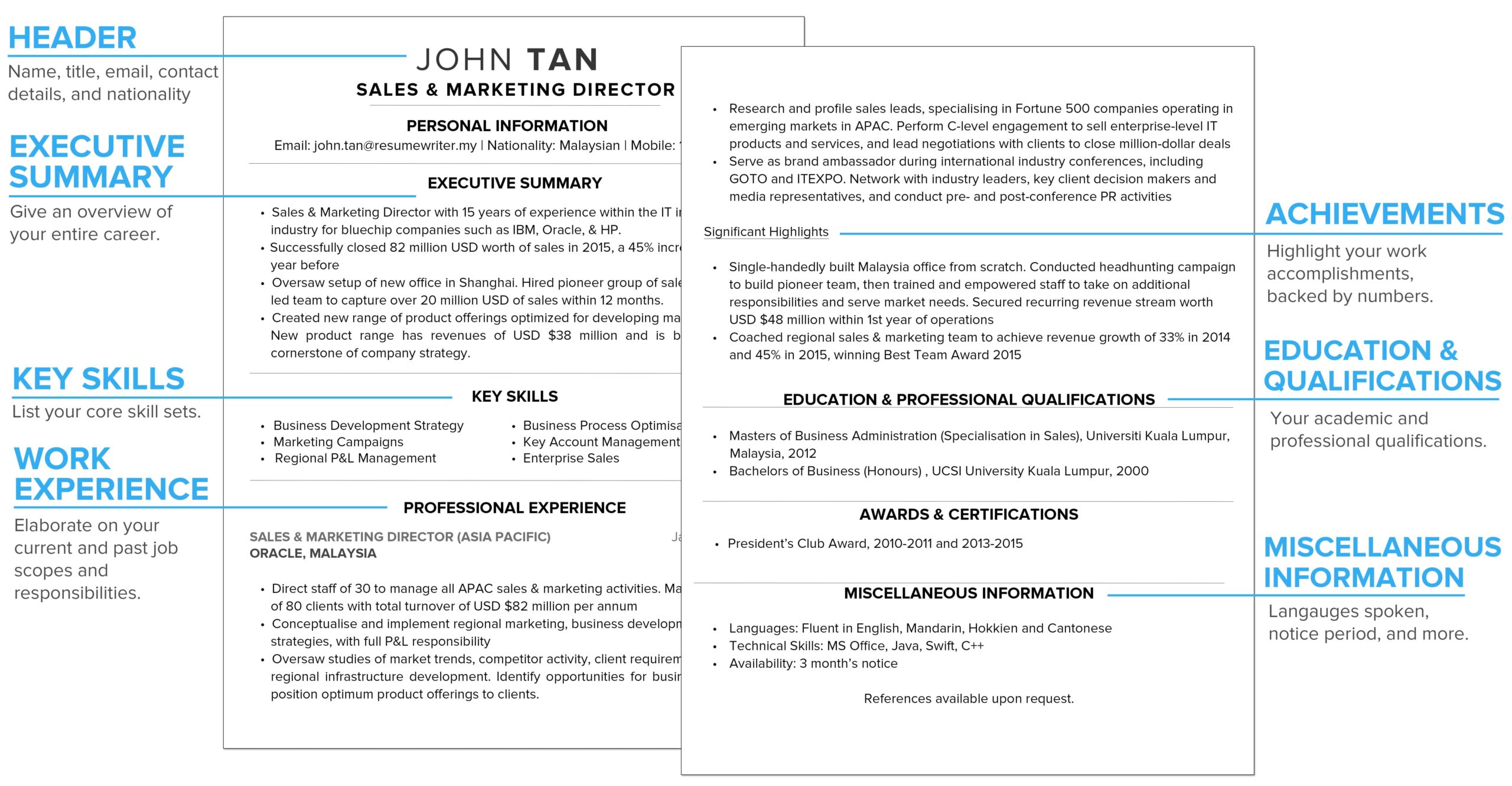
A few weeks after closing the case, we did a short follow up to check on John’s job search progress (we do this for all our clients).
He replied with this email:
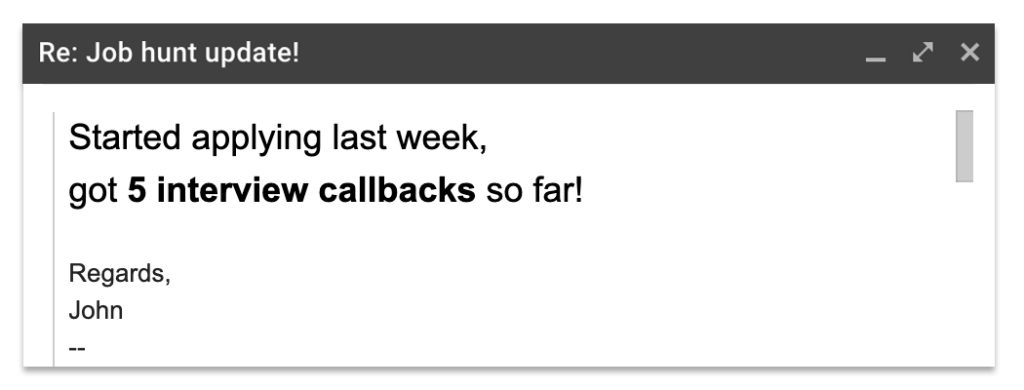
WOW!
Now, I know we produce great CVs but even this blew our mind.
How did John get such amazing results with the new CV we wrote for him? What did we do differently this time around?
So I retraced our steps, and noted down each phase of the CV writing journey – clearly outlining key decisions we took.
The result was this Ultimate CV Writing Guide.
This guide is so detailed, we actually use it to train our OWN team of professional writers.
And now, we’re opening up our secret CV writing playbook to you as well.
Follow the below steps, and you too will have a killer CV that lands you interview after interview.
| NOTE: While we’ve tailored this Guide for jobseekers in Malaysia, our tips are general enough for job applicants all around the world. |
- What is a Resume
- How Long should a Resume Be?
- What’s the Difference between CV and Resume?
- How to Write a Resume
- Done With Your CV? What’s Next?
What is a Resume?
Simply put, it’s a factual document summing up your career history: your work experience, skill sets and accomplishments.
That’s how most job seekers view it anyway.
And they’re wrong.
Your CV is more than a historical representation of your work history – it’s a MARKETING pitch.
When written correctly, a CV is a captivating force that compels the reader to call you for an interview.
We won’t lie. Polishing up a CV is tough work. But if you’d like, we can take your CV writing completely off your hands. Explore our CV writing services here.
ResumeWriter Tip: Of course, a stellar resume is not enough to land you a job. You absolutely need a Cover Letter too! Remember: job-hunting is a two-piece puzzle, so fill in the missing piece with our Ultimate Cover Letter Guide.
What is the Difference between CV and Resume?
We know it’s confusing! The technical explanations are:
- Curriculum Vitae (CV): an in-depth document detailing your entire career history. Often under 3 pages
- Resume: a short, 1-page career overview
But in Malaysia, CV and Resume are used interchangeably to refer to the same document.
How Long Should My Resume be?
The short answer? Keep it under 3 pages.
When John first came to us, his resume was over 5 pages long. It listed every job stint of his, including his stint in the military.
That’s actually THE most common mistake that most job seekers make.
Take it from recruiters like us – we hate long CVs.
We’re not here to read a data dump of your entire work history. We only want to know the most relevant parts.
A long, extremely detailed resume doesn’t present you as a stronger candidate.
As a rule of thumb, the more concise your CV, the better. Leave out fluff and irrelevant details.
A maximum CV length of 2-3 pages is generally acceptable for job openings in Malaysia.
If you’re coming into the workforce as a fresh graduate, or have fewer than 5 years of experience, keep your CV within 2 pages.
If you’re a mid to senior level candidate, you have enough work experience to justify a 2-3 page CV.
ResumeWriter Tip: Wondering what a CV looks like for a specific industry or career stage? Check out our wide range of 50+ downloadable CV samples.
How to Write a Resume
Great! With the basics covered, let’s continue John’s story.
This was John’s original CV, which he sent to us for Free CV Feedback.

Now, John’s CV wasn’t that bad. Truthfully, it was far better than most CVs we’d seen come through our email inboxes.
This CV had an issue though – it wasn’t getting John interviews to those senior positions he was gunning for.
ResumeWriter Tip: If you’re not getting the interviews you deserve, reach out to us for help. Sign up for our CV feedback session. It’s completely free of charge. Sign up and one of our seasoned recruiters will take a look at it and give you personalised feedback.
So we stepped in to take it off his hands. After hours of interviews with John, we came up with a brand new CV.
This is what his WINNING resume looks like now:

That’s so much better!
ResumeWriter Tip: Want a CV just like this? Just download one of our customisable CV samples and write one yourself, following the steps of our guide. Or you can check out our professional CV writing services
Now, back to John’s story. How did we revamp John’s CV?
First, we separated his resume into different sections. Every section has a unique purpose.

Structuring Your Resume
Begin with a professional Header. Include your name, career title, email, contact details and nationality.
Next, arrange your CV into 6 key sections:
1. Executive Summary:
Purpose: Share your career narrative and give an overview of your entire career
2. Key Skills:
Purpose: Tell recruiters your core skill sets – focus on hard skills – at first glance.
3. Work Experience:
Purpose: Elaborate on your current and past job scopes and responsibilities.
4. Achievements: Your Competitive Advantage
Purpose: Highlight your specific accomplishments in each role.
5. Education & Qualifications:
Purpose: Showcase your academic and professional qualifications.
6. Miscellaneous Information:
Purpose: Additional AND relevant information about you, such as languages spoken and your notice period.
ResumeWriter Tip: Alternatively, just download one of our ATS Friendly CV Templates! All the relevant sections are already laid out and pre-filled for you. 🙂
How to Start a Resume
Use a Professional and Appropriate Header

Keep it clean and simple!
Includes your name, career title, email, contact details and nationality.
Notice that your career title doesn’t have to be your actual job title. (ie. Sales & Marketing Director)
You can match this to the job title in the job advertisement – like John has done – provided it’s still an accurate reflection of your role, of course.
An identical job title immediately catches the attention of the Hiring Manager and warrants their further interest.
ResumeWriter Tip: Always match your CV title to the job title of the advertisement you’re applying for.
Do:
- Keep your header short and sweet
- Include only your essential contact information
- Use a professional email address
Don’t:
- Include your address, photograph or date-of-birth – these aren’t necessary and may subject you to unconscious hiring biases
How to Write an Executive Summary
The summary is the opening paragraph of your CV. Think of it as your elevator pitch.
Recruiters often only spend 6 seconds reviewing a CV. Half of that time is spent in the executive summary.
As a jobseeker, your goal should be to craft an executive summary that compelsthe recruiter to go on to read the next section of your CV.
So use this section wisely – fill it only with the most relevant, most impressive bits of your career.
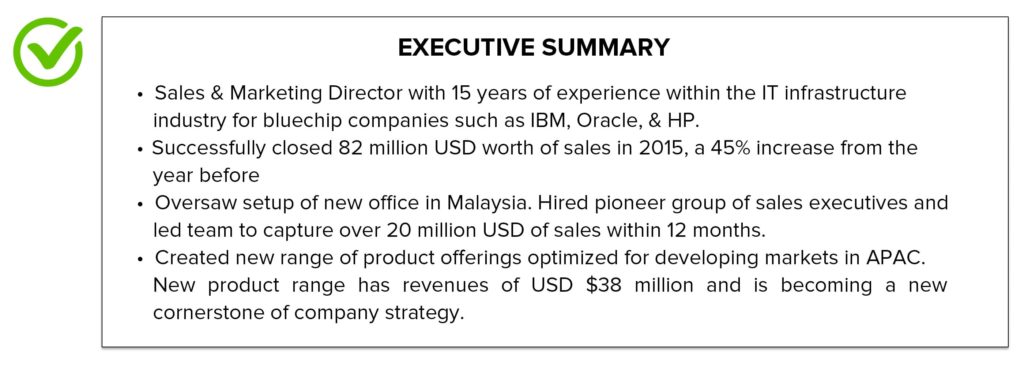
Note how we started off John’s Executive Summary. If you were a recruiter, would you be compelled to keep reading on?
Likewise for you, these opening lines MUST draw attention to your top selling points.
Demonstrate that you have the skills, experience and achievements to thrive in the position you’ve applied for.
If you’re uncertain how to start, think about the story of your career – we call it a career narrative.
ResumeWriter Tip: Before you begin your Executive Summary, write your Work Experience and Achievements sections. Once you’ve nailed these, it’s easier to define your personal narrative and career overview.
How To Craft Your Career Narrative
Human beings love the lure of a good story. So when selling your career, channel your inner J.K. Rowling – craft a captivating story that sucks the reader in.
Write something unique that sets you apart from competitors.
Make yourself memorable to the recruiter.
One of our clients was gunning for senior software sales positions. So when crafting his narrative, we emphasised his prior background as a programmer.
| Former Software Developer turned B2B SaaS Sales Director… |
We didn’t say that this candidate is just any B2B SaaS Sales Director. There are far too many sales directors competing for the same role!
By positioning him as a former Software Developer turned B2B Sales Director, he stands out from the sea of applicants.
This narrative tells recruiters: This candidate isn’t just an excellent salesperson. He also has deep knowledge of the technical aspects of software design.
Who better to convincingly sell software solutions than a passionate salesperson who actually understands the technology, through and through?
This career narrative clearly defines and elevates the candidate’s competitive advantage.
Avoid Motherhood Statements
Here’s another thing that recruiters really hate – Motherhood Statements!
Below is a classic example:
“Dedicated executive with excellent communication skills geared towards building relationships across organisational levels.”
Statements like those contain a lot of bombastic words. But when you really pull them apart, what are they actually saying?
“I work hard, communicate well and can interact well with both my bosses and subordinates”
Hardly impressive, no?
So why then do jobseekers include lines like that in their CV?
This is why recruiters hate motherhood statements so much. They occupy a lot of space and communicate NOTHING about the candidates’ real ability.
If you want to impress the recruiter, avoid using motherhood statements. Instead, use metrics!
Substantiate Your Claims with Metrics
John’s claims in his CV are now backed by relevant metrics: revenue delivered and sales captured, within specific timeframes.

Compare this with his original Executive Summary:
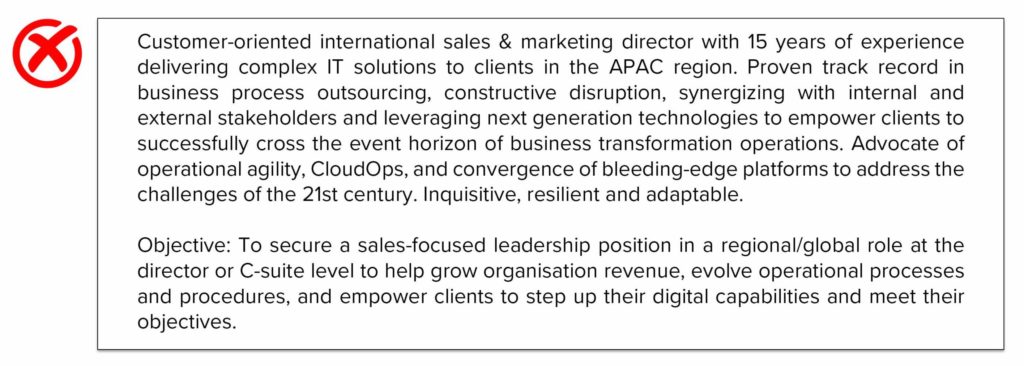
If you were the hiring manager, reading these 2 versions, which candidate would be more attractive to you?
John’s original Executive Summary was literally a wall of text riddled with motherhood statements that don’t actually say anything. The poorly formatted paragraph also repels hiring managers at first glance.
His new Executive Summary is far more concise, and embedded with various metrics. At a glance, you can tell just how significant John’s achievements are.
Numbers give claims far more weight, while using fewer words. They also personalise John’s Achievements – only he can deliver his results.
So always substantiate your claims with metrics.
If you’re struggling to think of suitable metrics to use, ask yourself these questions:
- What was the amount of new business you secured?
- How much revenue did this project bring in?
- What was the size of the budget you managed?
- How many team members did you work with or lead?
- How many new customers did you land as a result of this initiative?
We go deeper into metrics later, when we discuss Work Experience.
Include Your Most Impressive Achievements
In your executive summary, also toss in a few of your top career achievements.
There’s no need to add a long list of them. Just select 3 of the best achievements, ideally achievements which resonate closely to the role you’re applying for.
We have listed John’s most significant achievements in his executive summary, and supported them with metrics.

If you have more achievements, fret not. You can go into detail about those accomplishments later in your CV, under each relevant work stint.
We suggest crafting your Executive Summary after you’ve done your Work Experience and Achievements sections. This makes identifying your best achievements a lot easier!
Need more inspiration in crafting your achievements? Check out our guide to writing great career achievements here.
ResumeWriter Tip: Customise your CV for specific job ads by adding in relevant target keywords from the ad you are eyeing. This ensures your CV can be read by ATS Scanners, and lands in the recruiter’s hands!
Do:
- Spin a unique career narrative – you want to stand out!
- Include up to 3 of your most impressive achievements
- Substantiate these claims with metrics
Don’t:
- Use your Executive Summary to tell recruiters your life story – be concise!
How to Write Your Skills
List Skills at the Top of your CV
We’ve seen many jobseekers bury their skills section at the end of the CV. That’s a mistake!
Recruiters only eyeball each CV for an average of 6 seconds.
So, your key skills MUST be placed near the top for recruiters to see at first glance.
We embedded John’s skills right below the Executive Summary in his CV, and aligned these with the target keywords of the job ad he is applying for.

When crafting your Key Skills section, focus on higher value, hard skills, instead of soft skills. Why?
Hard skills have more impact and connect more easily with hiring managers. They also have much higher chances of being picked out as keywords in an ATS scan!
Do also group related skills together, so that they’re more easily digestible to hiring managers.
Order your skills from highest value skills at the top to lowest value below. Remember – skills that feature first are most likely to be read by recruiters!
It’s also crucial that each skill listed does not break at the end of a line and spill over into another line! ATS Scanners are not human – they cannot read across multiple lines like us.
ResumeWriter Tip: If you are in a technical role (such as Software Development), be sure to include technical skills, such as the programming languages and frameworks you are most familiar with.
Do:
- Focus on hard skills
- Order them such that your higher value skills feature first
- Group related skill sets together
Don’t:
- Include soft skills
Writing Your Work Experience and Achievements
Now, let’s get to the meat of your CV! The detailed workscopes of each work stint.
Craft a Powerful Opening Line To Each Work Stint
We’ll let you in on a secret:
Recruiters typically only glance at the first bullet point of each work stint, and skip the rest!
So, your first bullet point must communicate everything the recruiter needs to know about what you do, in one line.
Compare the first line of John’s original CV…

…with his reworked CV.

Isn’t the second opening line much better?
The first was far too vague!
Recruiters would have to go through the entire block of text below that line to decipher exactly what John’s role entailed (which they usually don’t have time to do!)
But the new opener tells recruiters everything about John’s work experience at Oracle.
It captures key roles and responsibilities in one succinct line, while giving recruiters a sense of scale of his scope.
It speaks volumes, with fewer words!
A powerful first line can contain:
- Team Size
- Geography (Local, Regional or International)
- Department
- Work Function
- Budget Managed
- Revenue Generated
- Who You Reported To/Liaised With/Led or Supervised
Kick off your Work Experience section with these details to impress recruiters!
Do:
- Capture the essence of the job in your first bullet point; include only key roles
- Substantiate your claims with numbers and metrics
Don’t:
- Make your first bullet point too long! Strive for a maximum of 3-4 lines.
A powerful first line entices the recruiter to read on.
But don’t stop here – keep the subsequent bullet points to be as IMPACTFUL as possible!
Here’s what we did for John:
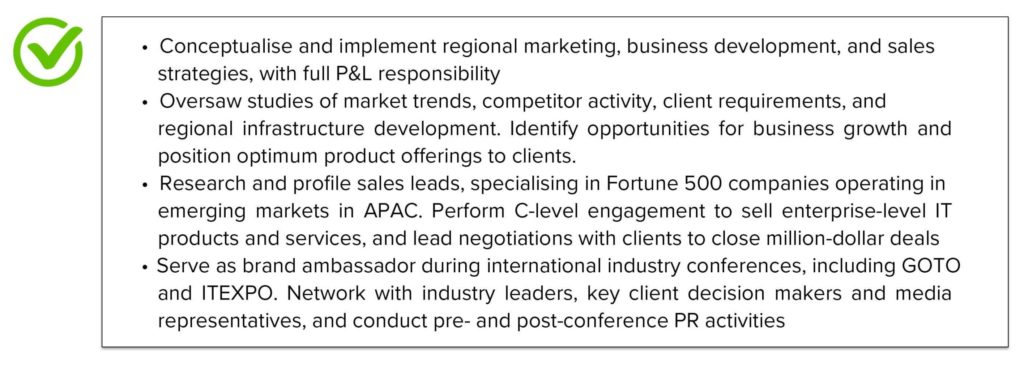
Compare this with his original Work Experience:
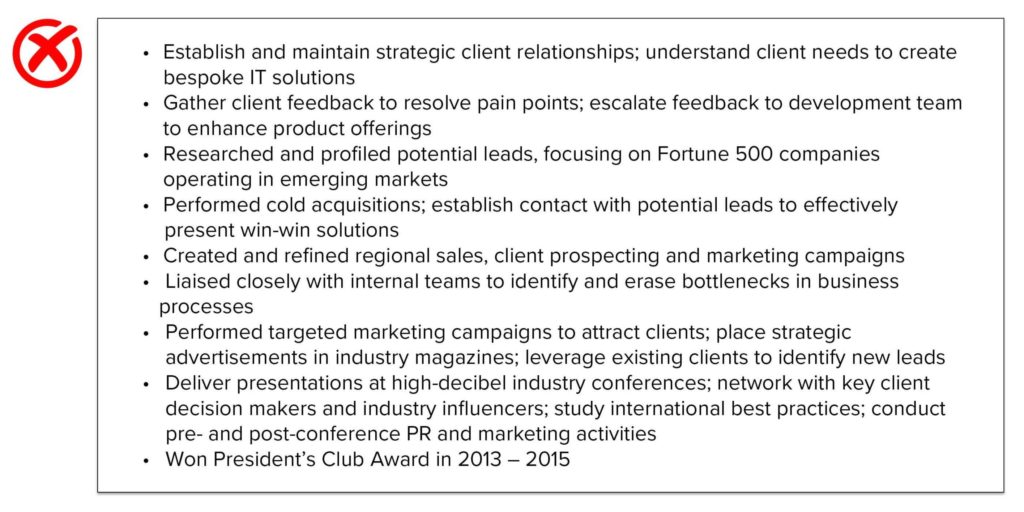
Can you spot the differences?
We’ve condensed the loooong list of responsibilities into much more succinct bullet points in John’s new CV.
Each bullet point drives greater impact and leaves a stronger impression on the hiring manager.
Use Power Verbs To Write Great Work Descriptions
Here’s another tip – when crafting descriptions of your prior work stints, use power verbs give your CV that extra oomph!
Power verbs are vivid, positive words that inspire confidence in your abilities.
Most jobseekers use statements like this:

Frankly, it’s quite boring and bland. Nothing to impress the reader.
Instead, replace verbs such as “Responsible” with stronger power verbs such as “Oversaw”, “Spearhead”, or “Supervise”.
Here are some of the power verbs we used in John’s new CV:

Doesn’t that read so much better?
Stand Out From The Pack – Highlight Your Achievements

That’s right – most people fail to realise the importance of including achievements.
Your work descriptions list your day-to-day experience. It’s your achievements though, which show you to be a stellar executive.
So how do you write great achievement statements?
Use our formula:
Accomplished [X] as measured by [Y] by doing [Z]
Take a look at how we applied that formula to John’s Achievements below:

Aren’t his career achievements super obvious and impactful?
This formula works because it tells recruiters two essential pieces of information:
- Scale and impact of results achieved
- What exactly you did to achieve these results
We’ll explain.
Every achievement contains an impactful, measurable outcome and a description of how the outcome was achieved.
For example:
“ – Negotiated 30% (US$500K) reduction in costs with IT Vendor for server maintenance by issuing public tender with well-defined scope of work, resulting in multiple competitive bids.”
Outcome – Impact of what jobseeker did
What Jobseeker Did – How jobseeker achieved that outcome
In your Achievements, use metrics as much as possible!
Numbers add a sense of scale, strengthening the impact of your results.
For example:
“Captured a 50% increase” is more impactful than“An increase”.
You can also indicate the time frame for this achievement.
“Captured a 50% increase in sales from $1M to $1.5M in 3 months”
It sounds more impressive that the candidate did this in just 3 months!
ResumeWriter Tip: Always substantiate your achievements with lots of metrics. Don’t claim you’re an expert – show the results you’ve delivered!
What kinds of Achievements can you include?
If you’re unsure how to start, here are 5 questions you can think about:
- How did you make the company more money?
- How did you save the company money?
- How did you increase productivity?
- How did you solve a critical problem?
- How did you lead a large project?
For more examples on how to write great achievements in your CV, click here!
Do:
- Emphasise your achievements in your Work Experience sections
- Use metrics as much as possible!
- Apply the magic formula to show impact and scale of your accomplishments
Don’t:
- Use confidential data directly in your CV!
Education & Professional Qualifications
Include Relevant Qualifications
Keep things simple here. Unless you’re a fresh graduate, no need to go into too much detail.

In this section, include your:
Academic Qualifications
If you’re a former Dean’s Lister or Award recipient, add it as a sub-bullet point under your educational stint.
E.g.
- Bachelor’s of Business (Honours), Nanyang Technological University, 2000
- Dean’s List Award Winner (Semester 2 – 99/00)
Professional Qualifications
Any industry-related or external courses or training that you’ve completed or are currently undertaking.
For example, if you’re a digital marketer, you can list your Google Ads certification here.
These should also include specific qualifications that allow you to do certain jobs. For example, the CPA or ACCA for Accounting, or degrees in Medicine or Law.
Miscellaneous Information
Pad your Miscellaneous Section with only relevant information.
This is how we reflected John’s Miscellaneous Information:

Written and spoken languages
We recommend including only languages that you have native or professional proficiency in.
Interests and hobbies
Don’t be shy to include more details about your hobbies here. You never know when the interviewer might have a similar hobby to you.
One client of ours was in the final round between 2 candidates – with not much between them. The hiring manager later admitted that the only reason he got the job was because they shared a deep passion for photography!
Availability and notice period
Indicate this clearly, for example: “1 month’s notice”
Salary details
Do not mention your expected salary in your CV! Salary information should only be negotiated in the later stages of the job offer.
References
If you have ready references, list them here. If not, simply mention that references are available upon request!
ResumeWriter Tip: If you are a foreigner with relevant residency in Malaysia (eg. Malaysian PR), be sure to list it in your CV. Having a valid work permit makes a huge difference in getting more interview calls.
Done With The Resume? What’s next?
Don’t forget your Cover Letter!
As we’ve shared, the job hunting process is a two-piece puzzle.

Your CV is the essential first half of the equation for landing your dream job.
But you still need a stellar cover letter if you really want to STAND OUT.
Learn how to write a Cover Letter with our Ultimate Cover Letter Guide.
Conclusion
As you can see, a well written CV is made up of so many little moving parts. It’s a lot of work.
Invest the effort upfront. Like a good lumberjack, sharpen your axe before you start cutting any wood. Work hard on your CV – it’ll make the job hunting process later so much easier.
When you get it right, the results are spectacular. Like our client John, who landed 3 interviews to the 3 jobs he applied for.
If you’re still struggling to land interviews, don’t lose hope. Reach out for help.
As recruiters, we know all the best CV writing tricks to get your application noticed – we’ve been doing this for over a decade.
Best of luck in your job search! 🙂
Disclaimer: The client testimonials and results achieved from our CV writing tips shared in this article are absolutely real. The character “John” and his story are being used for illustrative purposes only. Names and CV details have been changed to protect client confidentiality.

